SCI 228 Week 4 Midterm Exam (100% CORRECT ANSWERS)
Document Content and Description Below
1. Question : (TCO 1) Which of the following is NOT an essential nutrient? Student Answer: Water Alcohol Vitamins Minerals ... Instructor Explanation: Chapter 1 Question 2. Question : (TCO 1) Which of the following nutrients contains the element nitrogen? Student Answer: Carbohydrates Lipids Water Proteins Instructor Explanation: Chapter 1 Question 3. Question : (TCO 1) Which statement is FALSE concerning the field of nutrition? Student Answer: Nutrition is the study of how food nourishes the body. Nutrition encompasses how we consume, digest, metabolize, and store food. Nutrition is an ancient science that dates back to the 14th century. Nutrition involves studying the factors that influence eating Instructor Explanation: patterns. Chapter 1 Question 4. Question : (TCO 1) Which of the following nutrients is the most energy dense? Student Answer: Carbohydrate Lipid Protein Vitamin Instructor Explanation: Chapter 1 Question 5. Question : (TCO 1) For dinner, Bill consumes 255 grams of carbohydrate, 70 grams of protein, and 50 grams of fat. In addition, Bill decides that he wants a glass of wine with his meal. If he drinks one glass of wine containing 8 grams of alcohol, how many total kilocalories does he consume in this meal? Student Answer: 56 kilocalories 540 kilocalories 1,675 kilocalories 1,806 kilocalories Instructor Explanation: Chapter 1 Question 6. Question : (TCO 1) Which of the following is a micronutrient? Student Answer: Carbohydrates Vitamins Lipids Alcohol Instructor Explanation: Chapter 1 Question 7. Question : (TCO 2) Reduced rates of hypertension is the central objective of the: Student Answer: Food Guide Pyramid. 5-A-Day for Better Health Program. DASH diet. the Exchange System. Instructor Explanation: Chapter 2 Question 8. Question : (TCO 2) Which of the following is required on all food labels? Student Answer: the net contents of the package ingredient list the name and address of the vendor all of these Instructor Explanation: Chapter 2 Question 9. Question : (TCO 2) In which group are cheeses listed in the Exchange System? Student Answer: milk meat fruit starch Instructor Explanation: Chapter 2 Question 10. Question : (TCO 2) The type of study that observes a large population to determine factors that may influence nutritional habits and disease trends is called a(n): Student Answer: case controlled study. clinical trial. epidemiological study. animal study. Instructor Explanation: Chapter 1 Question 11. Question : (TCO 2) The second step of the scientific method is: Student Answer: observation and description of a phenomenon. testing a research question or hypothesis. generating a hypothesis. collecting data. Instructor Explanation: Chapter 1 Question 12. Question : (TCO 2) The 5-A-Day for Better Health Program was developed by the: Student Answer: American Dietetic Association. National Centers for Disease Control. National Dairy Council. National Cancer Institute. Instructor Explanation: Chapter 2 Question 13. Question : (TCO 3) Digestion and absorption occur at the level. Student Answer: tissue organ system organism Instructor Explanation: Chapter 3 Question 14. Question : (TCO 3) What is chyme? Student Answer: ulcerations of the esophageal lining healthy bacteria of the small intestine mixture of partially digested food, water, and gastric juices substance that allows for the emulsification of dietary lipid Instructor Explanation: Chapter 3 Question 15. Question : (TCO 3) Responding to the presence of protein and fat in our meal, cholecystokinin (CCK) signals the gallbladder to release a substance called: Student Answer: lipase. pepsin. chyme. bile. Instructor Explanation: Chapter 3 Question 16. Question : (TCO 3) Which best explains why carbohydrate digestion ceases when food reaches the stomach? Student Answer: Carbohydrate is completely digested in the mouth. Salivary enzymes cannot function in the acid environment of the stomach. Carbohydrate is completely absorbed in the esophagus. Intestinal bacteria are needed for carbohydrate digestion. Instructor Explanation: Chapter 3 Question 17. Question : (TCO 3) All of the following are found in saliva EXCEPT: Student Answer: water and mucus. enzymes. antibodies. bicarbonate. Instructor Explanation: Chapter 3 1. Question : (TCO 4) Peggy Sue's doctor wants to screen her for reactive hypoglycemia. If her doctor's suspicions are correct and Peggy Sue does have reactive hypoglycemia, what would you expect her blood glucose concentration to be at approximately TWO HOURS after she had begun her glucose tolerance test? Student Answer: elevated as compared to a normal individual depressed as compared to a normal individual normal; two hours after consuming the glucose load, her blood Instructor Explanation: concentrations will be no different from those of a normal individual. Chapter 4 Question 2. Question : (TCO 4) Gluconeogenesis is: Student Answer: the synthesis of new glucose from amino acids. the release of stored glycogen from the liver. the process by which plants use sunlight to synthesize glucose. the uptake of glucose by the body's cells. Instructor Explanation: Chapter 4 Question 3. Question : (TCO 4) Which of the following does NOT describe the cell membrane of an animal cell? Student Answer: rigid barrier resistant to all noncellular molecules structurally organized into a lipid bilayer dynamic and continuously changing perimeter structure of the cell that is composed of phospholipids, Instructor Explanation: cholesterol, proteins, and carbohydrate chains Chapter 3 Question 4. Question : (TCO 4) Which of the following is associated with the development of ketosis? Student Answer: a diet that contains too much fat a diet that contains insufficient fat a diet that contains too much carbohydrate a diet that contains insufficient carbohydrate Instructor Explanation: Chapter 4 Question 5. Question : (TCO 4) The term complex carbohydrates refers to: Student Answer: monosaccharides. disaccharides. polysaccharides. glucose. Instructor Explanation: Chapter 4 Question 6. Question : (TCO 4) Over 16 million Americans have diabetes. Which of the following is the most prevalent form of diabetes? Student Answer: type 1 type 2 gestational pediatric Instructor Explanation: Chapter 4 Question 7. Question : (TCO 4) Which of the following enzymes is found in the mouth? Student Answer: lactase maltase pancreatic amylase salivary amylase Instructor Explanation: Chapter 4 Question 8. Question : (TCO 4) Which of the following is a disaccharide? Student Answer: sucrose fructose galactose glucose Instructor Explanation: Chapter 4 Question 9. Question : (TCO 1-6) Which government agency regulates organic farming standards in the United States? Student Answer: Food and Drug Administration United States Department of Agriculture Environmental Protection Agency Centers for Disease Control Instructor Explanation: Chapter 18 Question 10. Question : (TCO 1-6) Pesticides are: Student Answer: chemicals added to food to enhance them in some way. chemicals added to food that help prevent microbial spoilage and enzymatic deterioration. chemicals used in the field and in storage areas to decrease destruction caused by insects and fungus. chemicals produced by microorganisms that harm tissue and elicit Instructor Explanation: an immune response. Chapter 18 Question 11. Question : (TCO 1-6) Which government agency regulates the labeling, sale, distribution, use, and disposal of all pesticides in the United States? Student Answer: Food and Drug Administration United States Department of Agriculture Environmental Protection Agency Centers for Disease Control Instructor Explanation: Chapter 18 Question 12. Question : (TCO 1-6) Which human organ system is most affected by toxic levels of mercury? Student Answer: nervous renal cardiovascular digestive Instructor Explanation: Chapter 18 Question 13. Question : (TCO 1-6) Which of the following are the most common form of pesticides? Student Answer: insecticides herbicides fungicides biopesticides Instructor Explanation: Chapter 18 Question 14. Question : (TCO 1-6) The food-borne illness caused by Campylobacter jejuniis associated with consuming: Student Answer: grains that have been stored in a moist environment. water that has been contaminated with fecal material. tapeworms. contaminated beef or pork. Instructor Explanation: Chapter 18 Question 15. Question : (TCO 1-6) The easiest and most effective way to prevent food-borne illnesses is to: Student Answer: wash hands before handling food. separate foods to avoid cross-contamination. chill foods to prevent microbes from growing. cook foods to their proper temperature. Instructor Explanation: Chapter 18 Question 16. Question : (TCO 1-6) An estimated of all chicken eggs in the U.S. are contaminated with Salmonella. Student Answer: one-fifth one-fourth one-third one-half Instructor Explanation: Chapter 18 Question 17. Question : (TCO 1-6) In which of the following environments doesClostridium botulinum flourish? Student Answer: acidic alkaline F > 140F Instructor Explanation: Chapter 18 1. Question : (TCO 5) All of the following are major classes of dietary lipids EXCEPT: Student Answer: glycogens. triglycerides. sterols. phospholipids. Instructor Explanation: Chapter 5 Question 2. Question : (TCO 5) Transport vehicles for most lipids are called: Student Answer: lipoproteins. peptides. monoglycerides. glycerols. Instructor Explanation: Chapter 5 Question 3. Question : (TCO 5) The two essential fatty acids are: Student Answer: cholesterol and bile. linoleic and alpha-linolenic acid. butyric and stearic acid. cis and trans. Instructor Explanation: Chapter 5 Question 4. Question : (TCO 5) Which type of dietary fat is known to elevate blood cholesterol levels? Student Answer: Saturated Trans Monounsaturated Both saturated and trans Instructor Explanation: Chapter 5 Question 5. Question : (TCO 5) Which of the following statements is FALSE regarding the process of hydrogenation? Student Answer: Hydrogenation creates trans fatty acids. Hydrogenation is the process in which hydrogen atoms are added to double bonds. Hydrogenation creates a heart-healthy product. Hydrogenation makes a product more solid at room temperature. Instructor Explanation: Chapter 5 Question 6. Question : (TCO 5) A fatty acid that contains a chain of 10 carbons and one double bond is termed a: Student Answer: saturated, medium-chain fatty acid. saturated, long-chain fatty acid. monounsaturated, medium-chain fatty acid. monounsaturated, long-chain fatty acid. Instructor Explanation: Chapter 5 Question 7. Question : (TCO 5) Which of the following is a rich source of polyunsaturated fatty acids? Student Answer: Corn oil Coconut oil Beef fat Butter Instructor Explanation: Chapter 5 Question 8. Question : (TCO 5) The process of adding hydrogen to an unsaturated fatty acid and creating a more solid fat is called: Student Answer: emulsification. pressurization. hydrogenation. deamination. Instructor Explanation: Chapter 5 Question 9. Question : (TCO 6) Oligopeptides are a string of amino acids. Student Answer: one to two four to nine 10-15 more than 25 Instructor Explanation: Chapter 6 Question 10. Question : (TCO 6) Well-planned vegetarian diets can reduce the risk of all of the following chronic diseases EXCEPT: Student Answer: obesity. heart disease. anemia. cancer. Instructor Explanation: Chapter 6 Question 11. Question : (TCO 6) Which of the following proteins are fundamental to the immune system? Student Answer: Enzymes Antibodies Buffers Transport proteins Instructor Explanation: Chapter 6 Question 12. Question : (TCO 6) Which of the following is a genetic disorder resulting in debilitating protein abnormalities? Student Answer: Cystic fibrosis Mad cow disease Acidosis Kwashiorkor Instructor Explanation: Chapter 6 Question 13. Question : (TCO 6) Which of the following is associated with marasmus? Student Answer: Distended abdomen "Skin and bones" appearance Enlarged, fatty liver All of these Instructor Explanation: Chapter 6 Question 14. Question : (TCO 6) All of the following are parts of an amino acid molecule EXCEPT: Student Answer: a central carbon. an amine group. an acid group. a fatty acid group. Instructor Explanation: Chapter 6 Question 15. Question : (TCO 6) The process of combining two incomplete proteins to make a complete protein is called: Student Answer: the protein combining method. amino acid sequencing method. mutual supplementation. protein. Instructor Explanation: Chapter 6 Question 16. Question : (TCO 6) Which of the following health problems has been associated with high protein intakes? Student Answer: Elevated blood cholesterol Marasmus Edema Sickle cell anemia Instructor Explanation: Chapter 6 [Show More]
Last updated: 1 year ago
Preview 1 out of 24 pages
.png)
Reviews( 0 )
Document information
Connected school, study & course
About the document
Uploaded On
Nov 05, 2022
Number of pages
24
Written in
Additional information
This document has been written for:
Uploaded
Nov 05, 2022
Downloads
0
Views
92





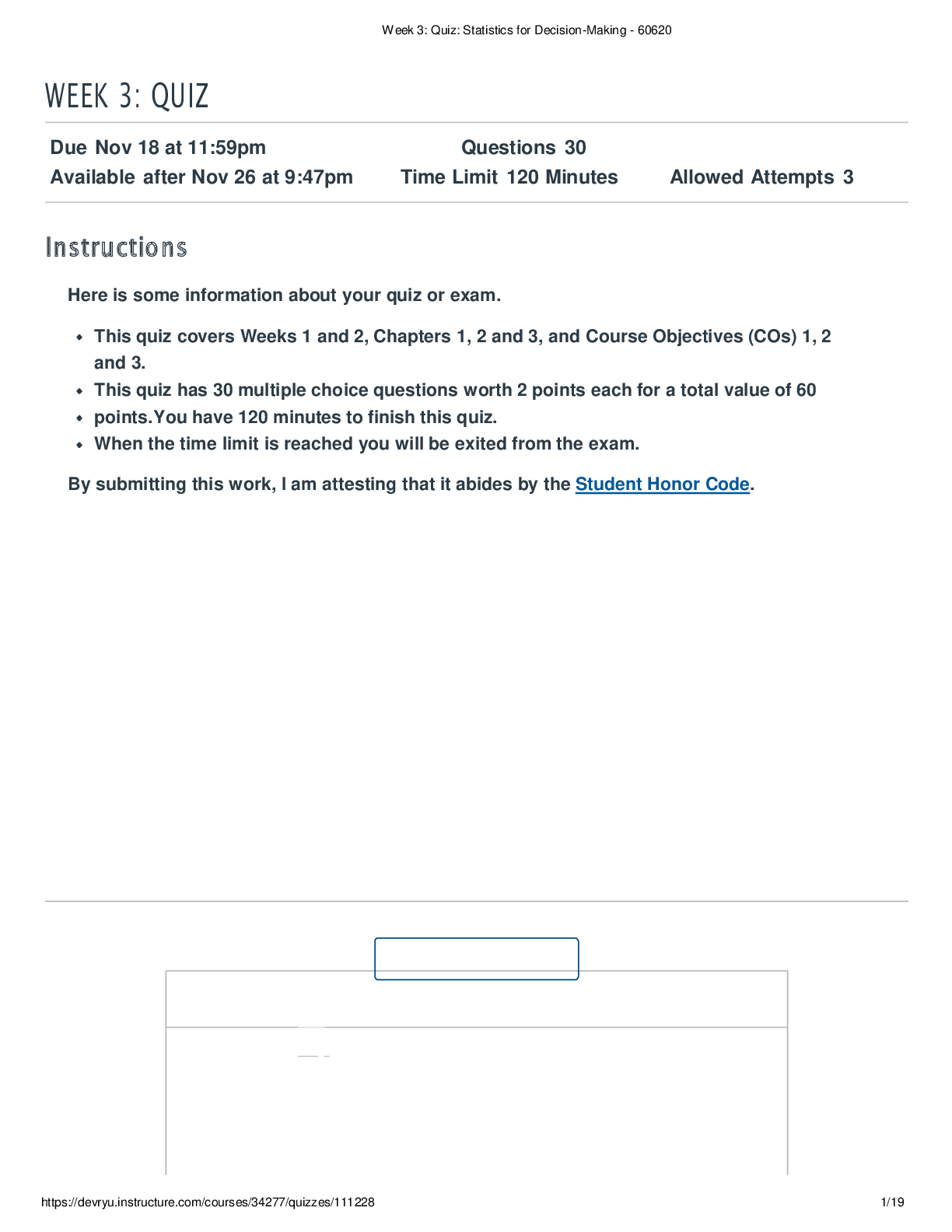

.png)










 – Chamberlain College of Nursing.png)
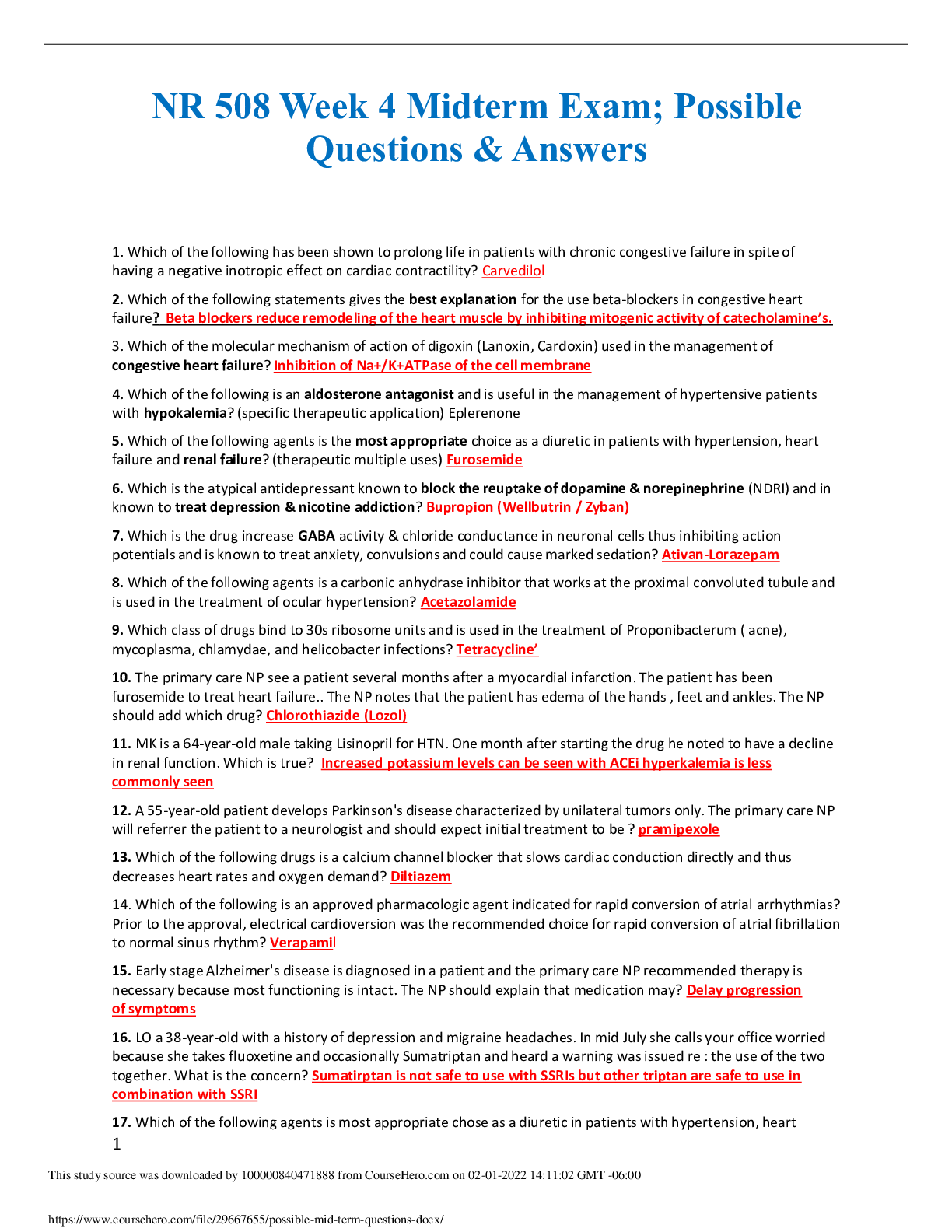
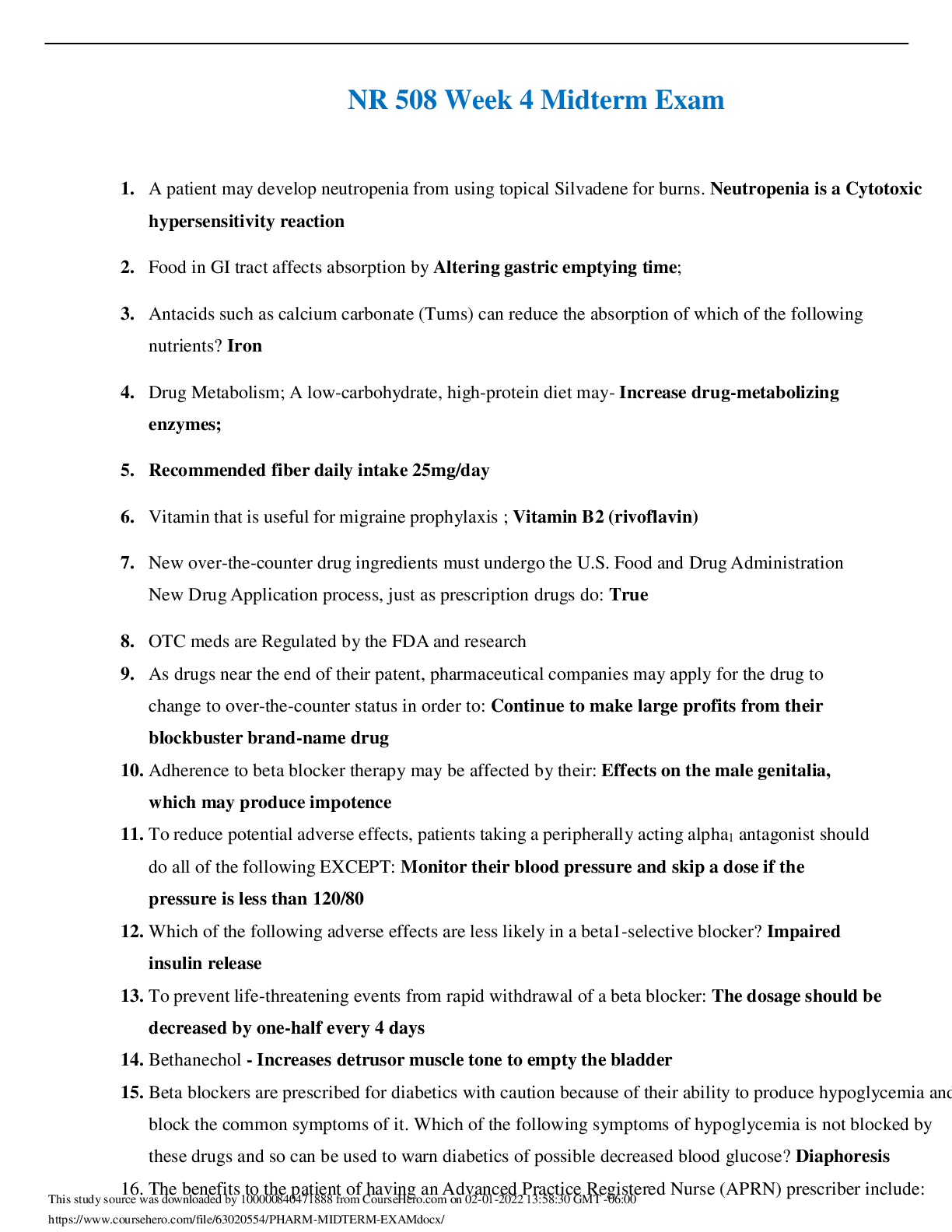
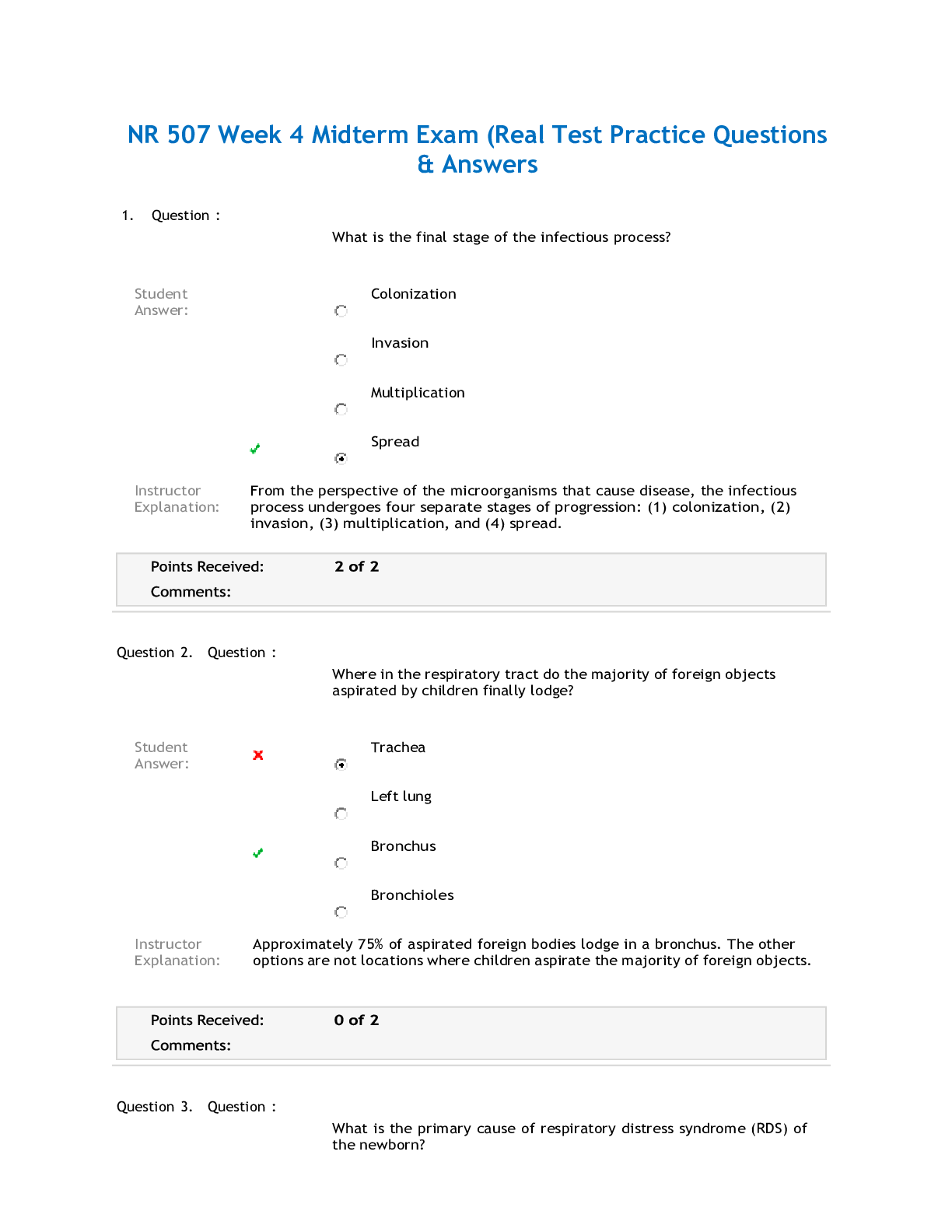
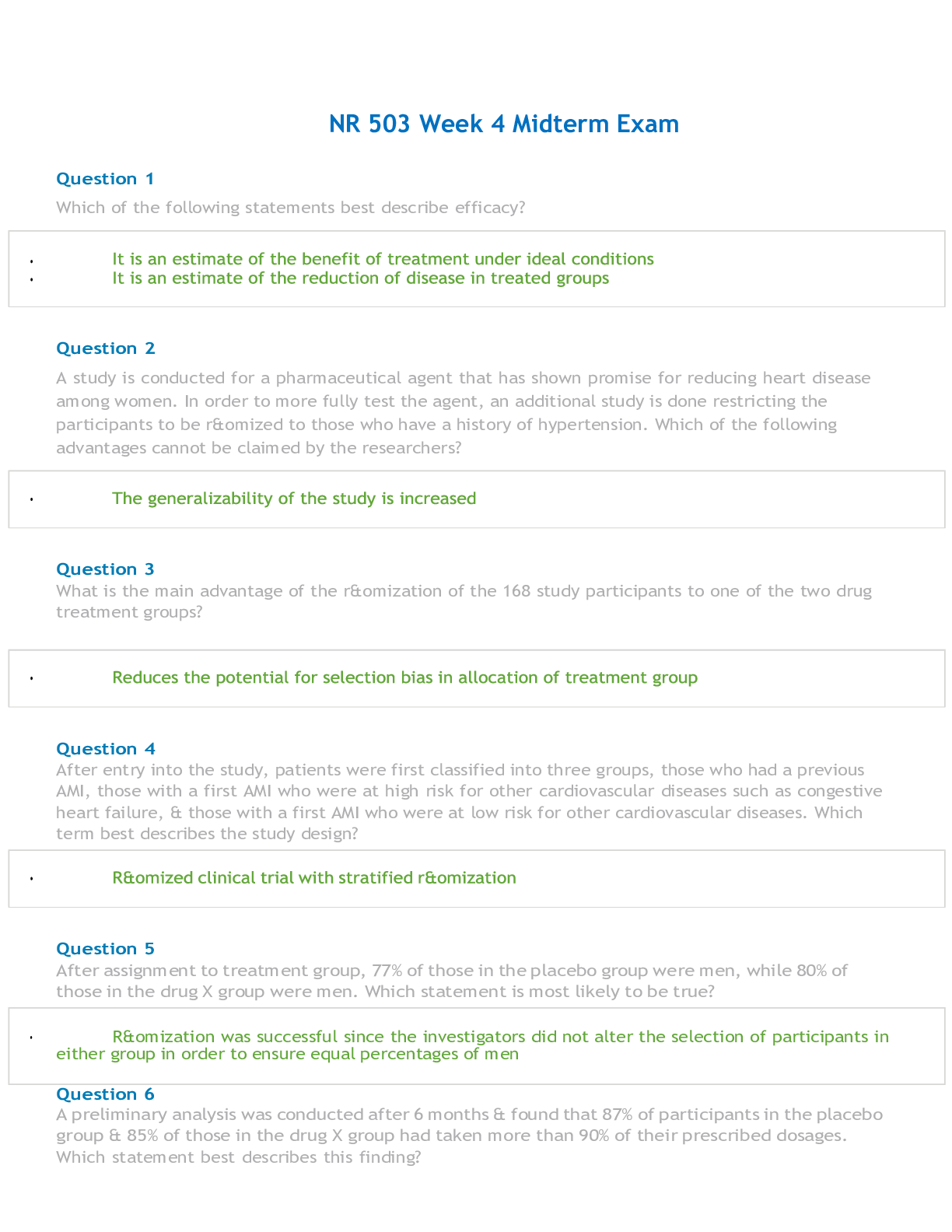
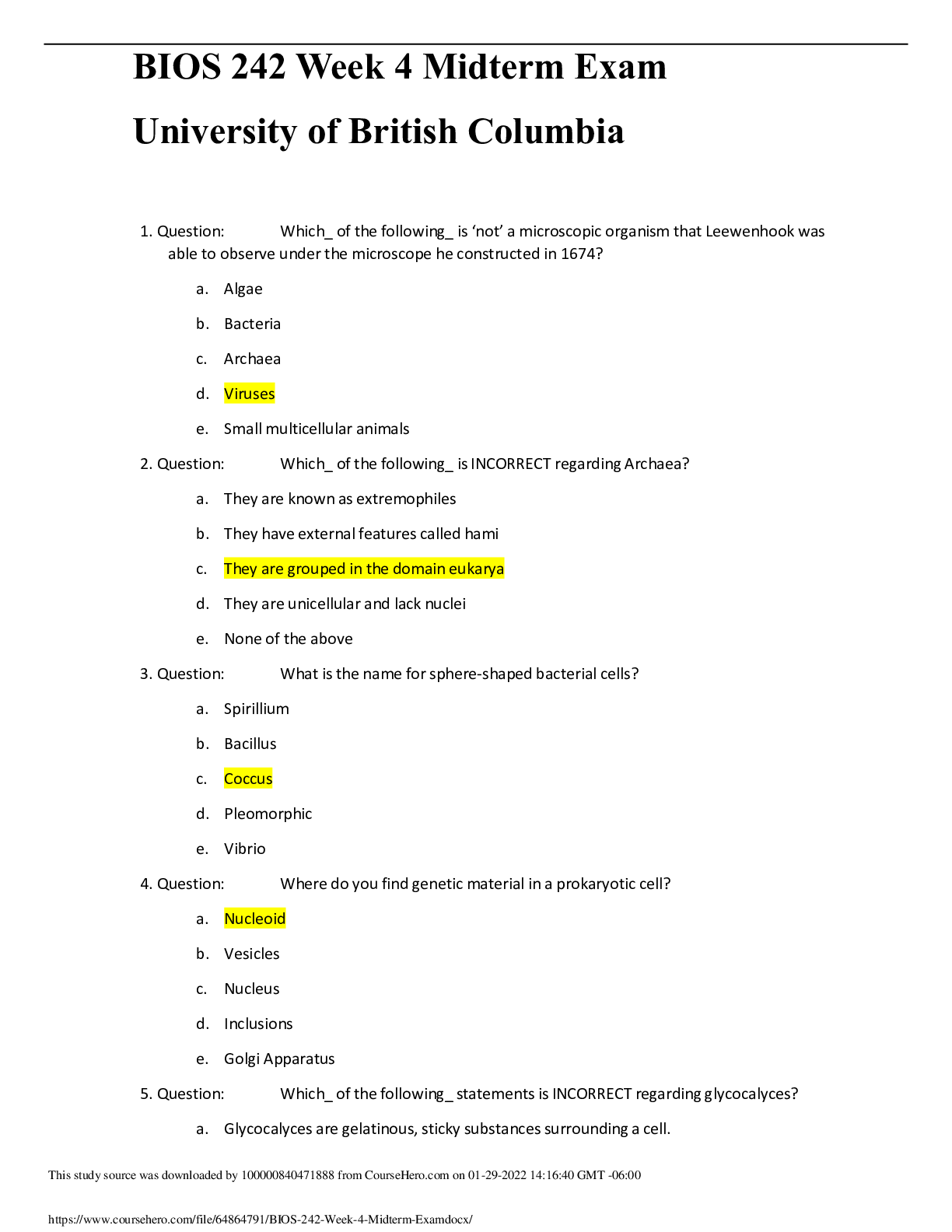
 – Chamberlain College of Nursing.png)
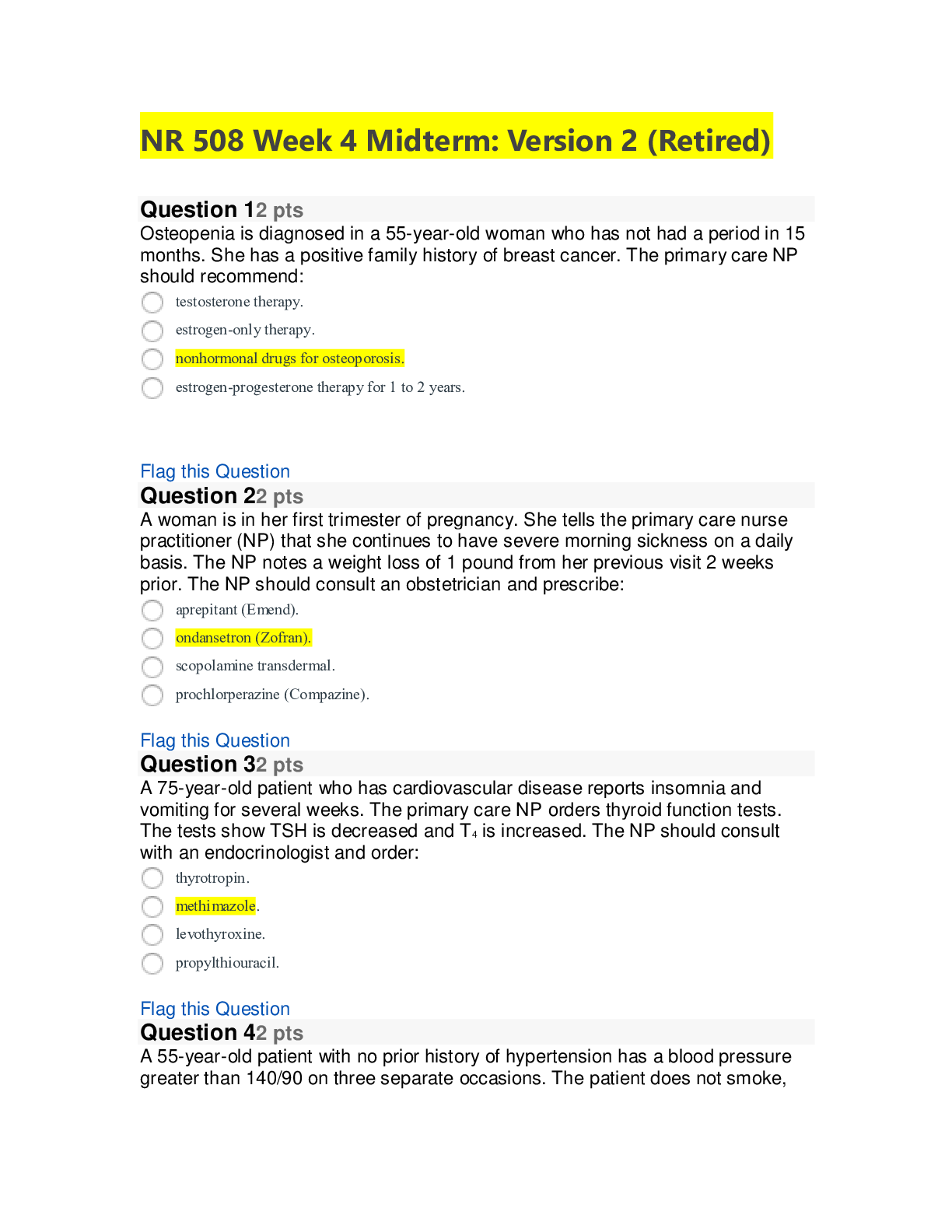
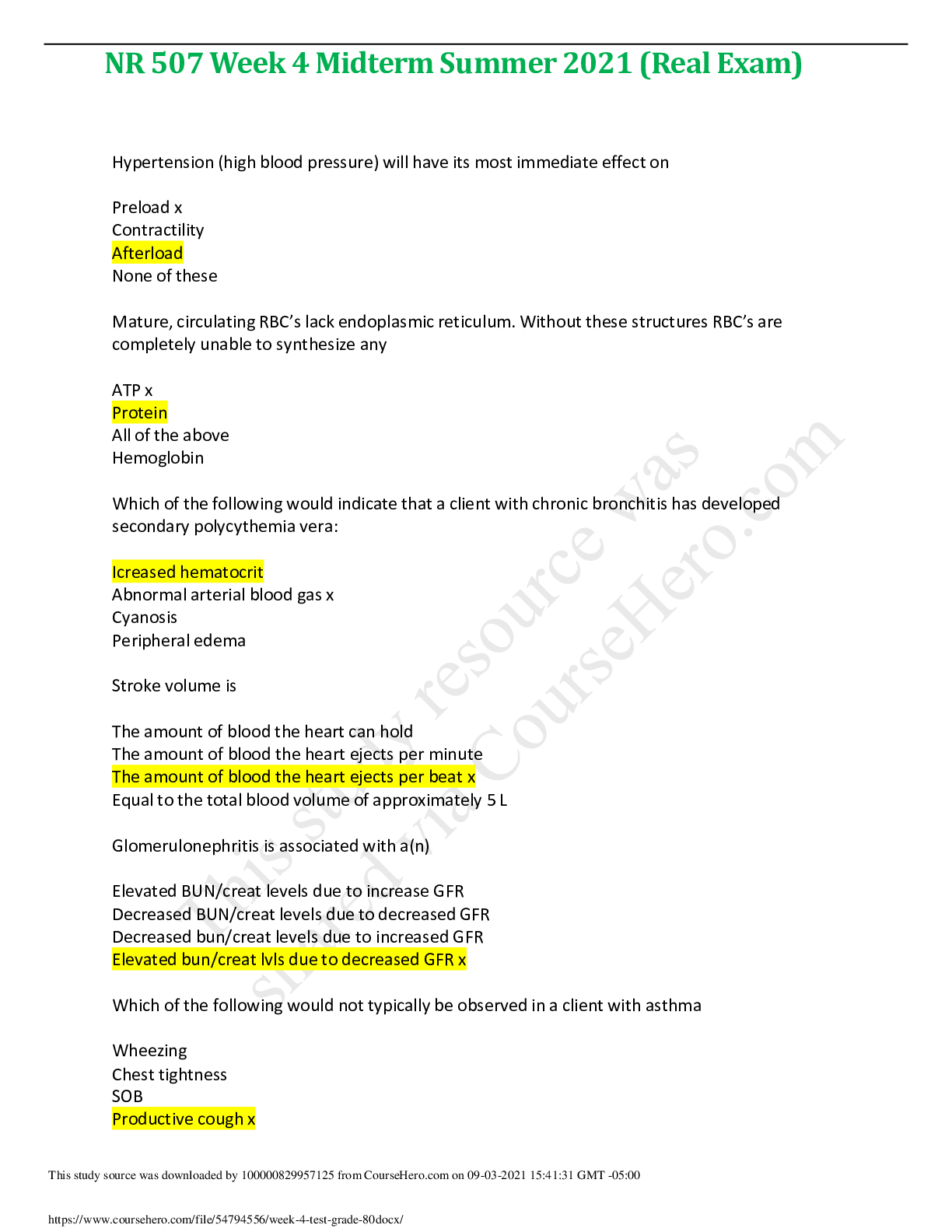
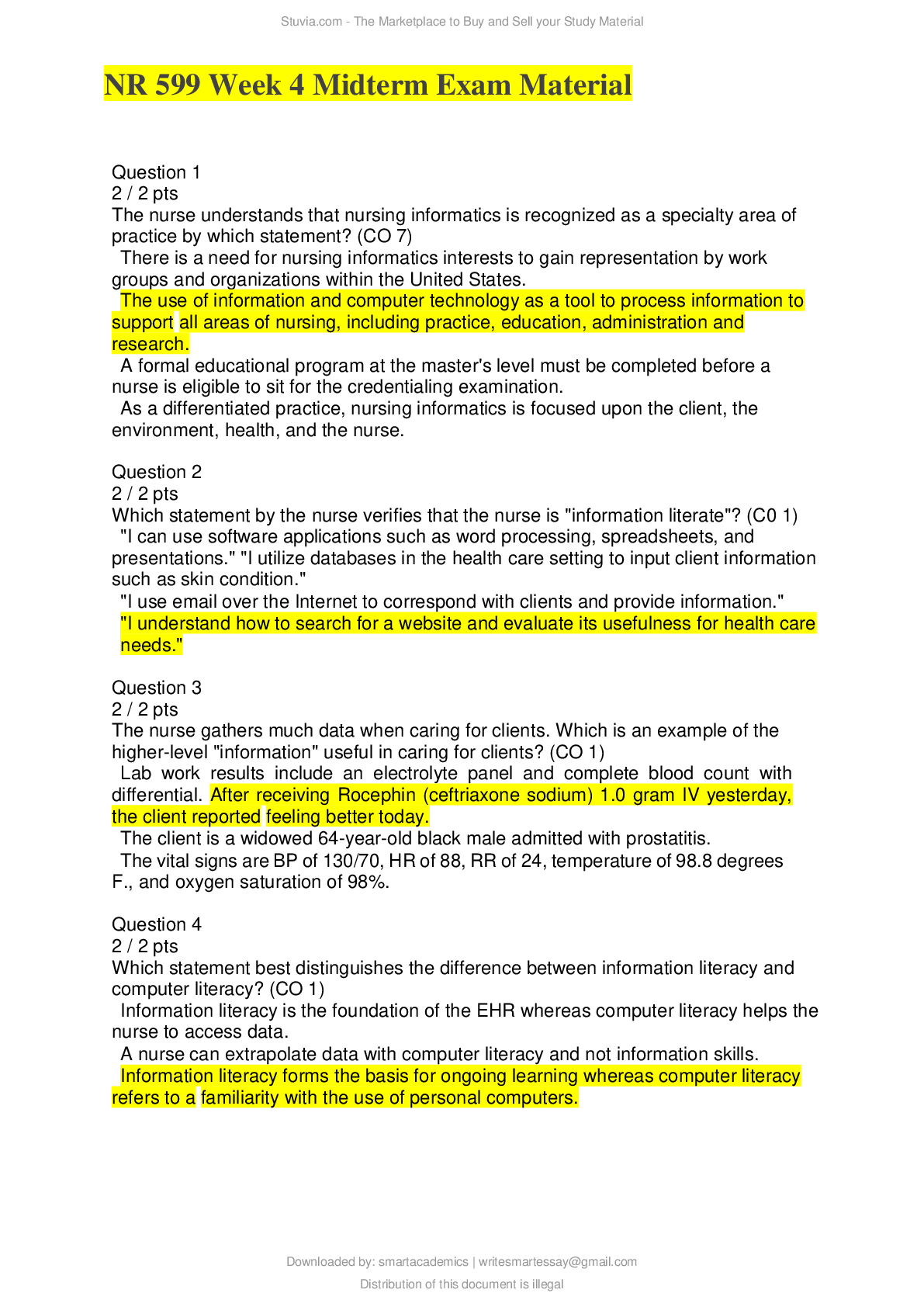

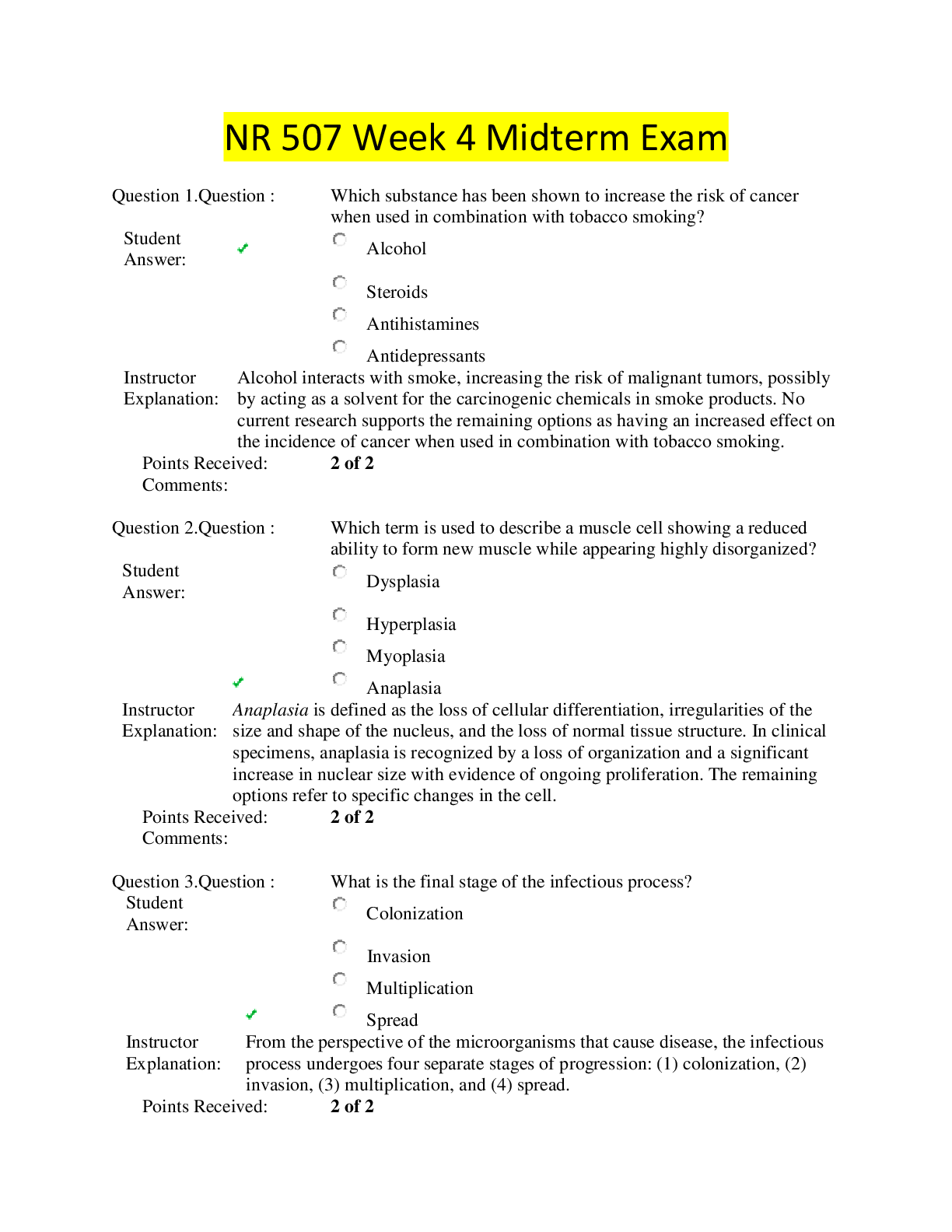
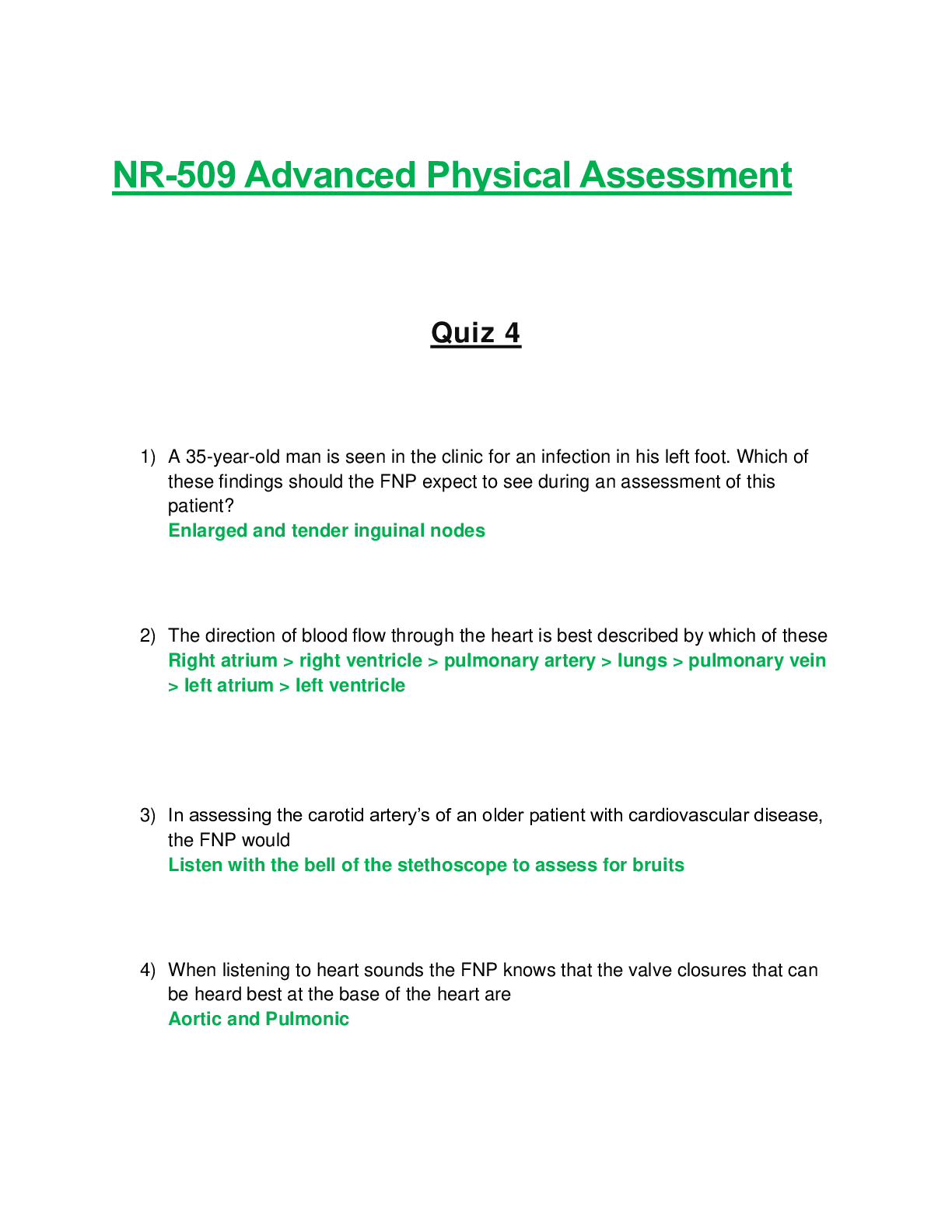
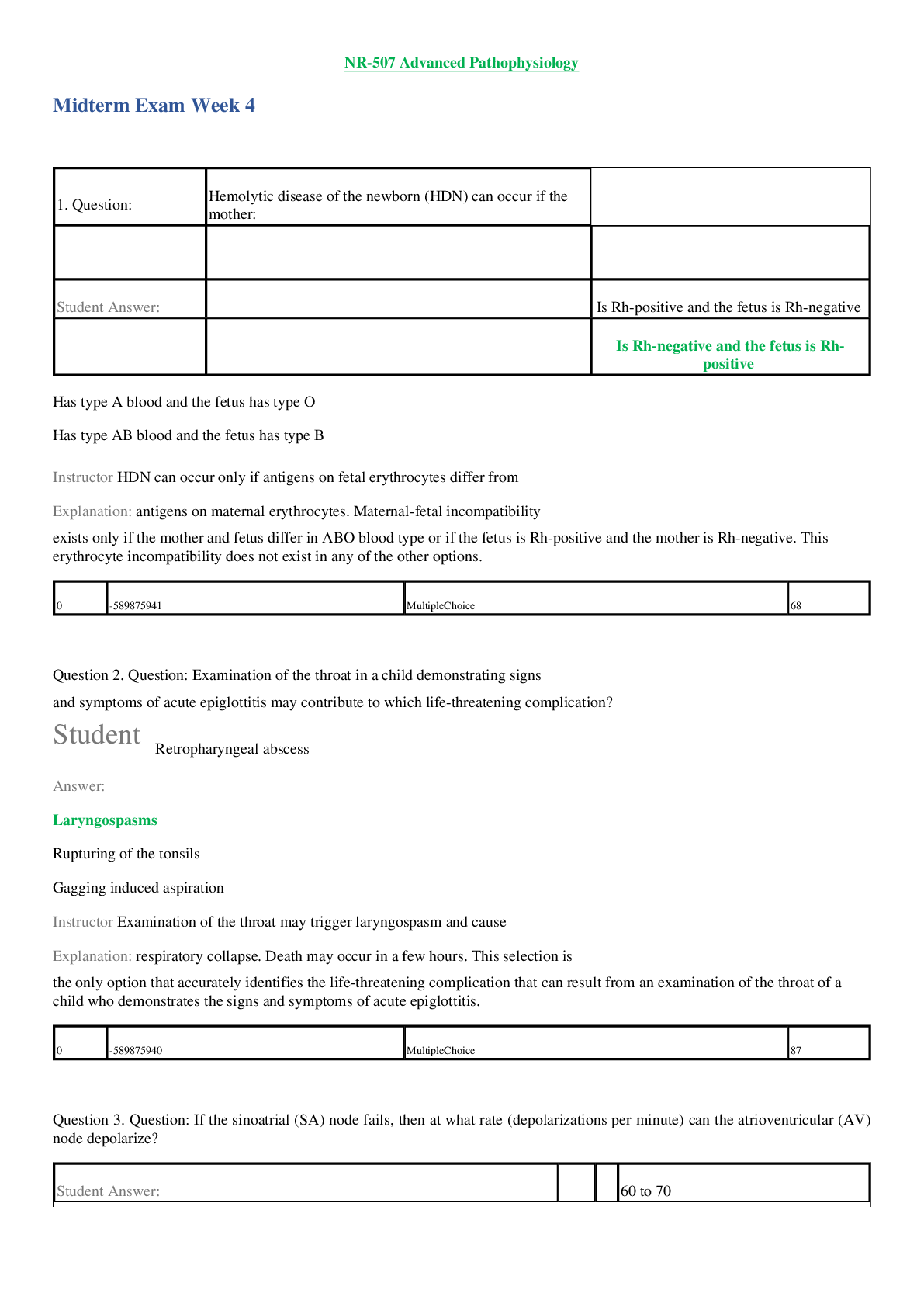
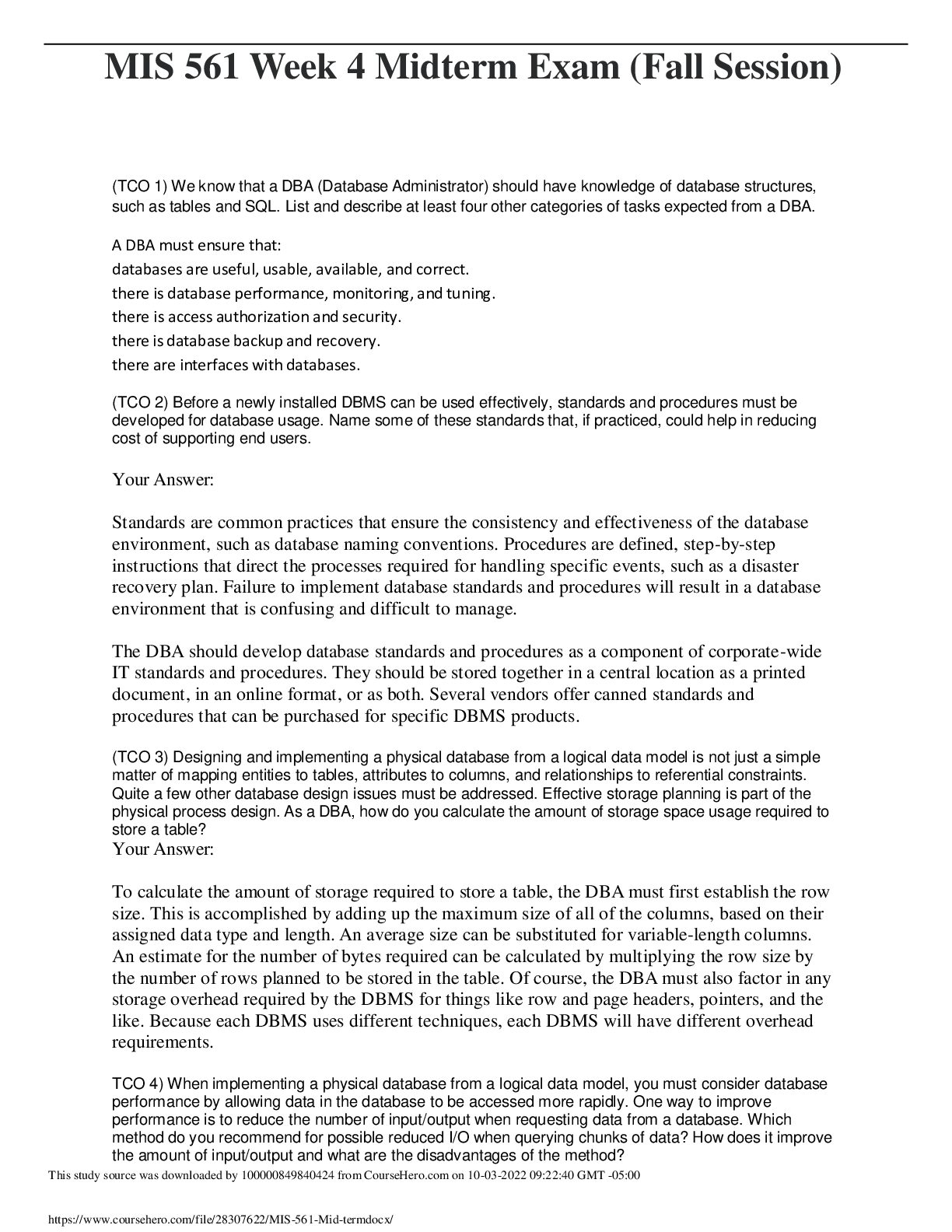
 (1).png)

